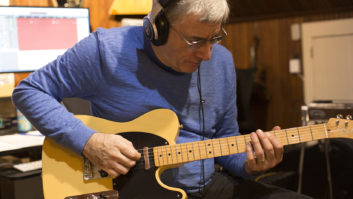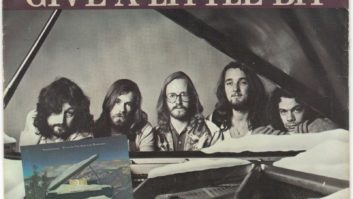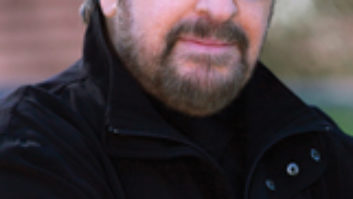‘Sonic Imprints’ participants included producers/engineers (l-r): Al Schmitt, Maureen Droney (senior executive director P&E Wing), Chris Lord-Alge, Phil Ramone, Ken ‘Duro’ Ifill, Steve Lillywhite and Ann Mincieli.NEW YORK, NY—Certain recording projects inevitably become milestones in any engineer or producer’s career, and some can even be life-changing experiences. At this year’s AES Convention, a Grammy SoundTable panel comprising Ken “Duro” Ifill, Steve Lillywhite, Ann Mincieli, Phil Ramone and Al Schmitt, with Chris Lord-Alge moderating, shared some of those career-defining moments with a standing-room-only audience.

The presentation entitled, “Sonic Imprints: Songs That Changed My Life,” returned to a theme that proved so popular at the convention in San Francisco last year that it bore repeating, this time with something of an East Coast flavor. “Why are we doing what we’re doing?” asked Lord-Alge rhetorically. The panelists were happy to share.
Lillywhite kicked off the proceedings with U2’s “Vertigo.” “I was like a school teacher to them,” he said, recalling his instructions to Bono to “go out [into the studio] and do a live vocal.” That led the singer to rewrite the lyrics to the song, which was originally called “Native Son.” “We turned that song around,” remarked Lillywhite.
“I mixed the song by hand,” he elaborated, on Sting’s mobile SSL E Series desk. “It was a performance, like the old days,” he said.
Lillywhite’s second song, Matchbox Twenty’s “How Far We’ve Gone,” was notable for being the first time he recorded two drum kits at the same time. “So many people think the groove comes from the drums. It doesn’t,” he commented.
It was The Beatles that set engineer Mincieli, who has worked extensively with Alicia Keys, on a path to build Manhattan’s latest high-end facility, Jungle City. “The Beatles were pioneers,” she said. Mincieli has collected much of the equipment with which The Beatles recorded, including a rare example of EMI’s TG12345 Abbey Road console, at her studio.
After Lord-Alge interjected with the obligatory joke (“How do you make a small fortune in the recording business? Start with a large one!”), Mincieli lamented, “Technology has disconnected us.” Playing Keys’ “Superwoman” for the audience, she noted that they instead take a “retro- futuristic” approach to recording, with all the musicians playing together in the room, while also mixing in programmed elements. Keys and her musicians also play and record a song from top to bottom, rather than copying and pasting a particularly wellplayed verse or chorus. “We try to remember where music comes from,” she commented, noting also, “It starts with the song.”
Keys both played piano and sang at the same time all the way through “Superwoman,” which took the record label by surprise when they called to request separate piano and vocal stems, Mincieli reported. “We’re making records, we’re not making stems,” commented Lord- Alge, to much applause.
“This record changed my life,” shared Schmitt, playing “The Peter Gunn Theme” by Henry Mancini, which was engineered by the legendary Bones Howe. A conflict in the control room landed Schmitt his life-changing gig, taking over the engineer’s seat on the Mancini album session that won the very first Grammy Award to honor the category of Record of the Year.
“It’s a great way to change your life,” he said of the 1958 direct-to- 2-track project. Although the Record of the Year award did not recognize the engineer when it was first introduced, Schmitt has since gone on to win many, many Grammy Awards.
Phil Ramone, too, benefited from studio politics. When “Everybody’s Talkin’,” sung by Harry Nilsson, was re-recorded for the film Midnight Cowboy, scoring composer John Barry asked Ramone to produce after butting heads with the original producer. “The word ‘producer’ in front of your name will change your life,” observed Ramone.
The song was originally included in the film’s temp track, he revealed, adding, “I think his was one of the great voices of all time.” The record later took off and became a big hit.
After playing “Check the Rhyme” from A Tribe Called Quest’s 1991 Low End Theory album, Duro recalled the first time he heard it: “It was the first time I’d heard a song that sounded like nothing else.” As a 17 year old at the time, he “dug around” to find out how and why it sounded like it did, and determined to become an engineer. “I wasn’t even sure if I could do it,” he admitted, noting also, “I wanted to become an engineer to learn from the producer.”
Having already commented that, “making music is the most important thing,” Lord-Alge recommended that engineers stay humble. “Who’s on the front cover? We’re not,” he pointed out. “We’re on the back cover making sure the guy on the front cover is well represented.”
AES
aes.org



